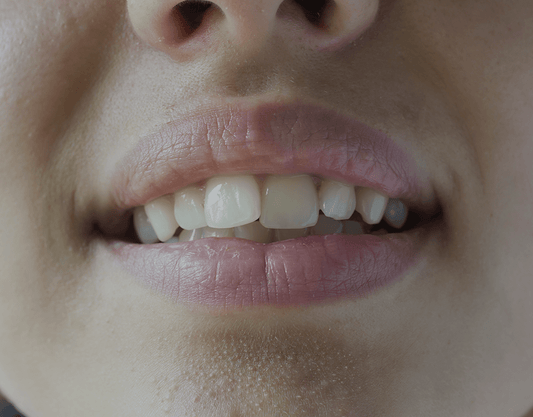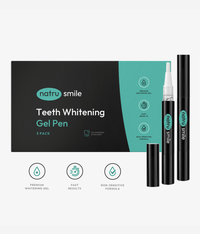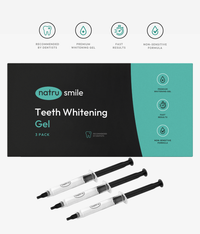
All products are certified by dental expert Dr. Greg Grillo
Crooked teeth are among the most common dental problems, with plenty of potential causes. The good news is that most cases can be treated with braces. However, the unique nature of each condition means that causes and treatment options vary on a case-by-case basis. This article tells you everything you need to know about what causes crooked teeth and how to fix them.
To some degree, almost everyone deals with crooked teeth. Nearly all of us have teeth that are somewhat misaligned, and three-fourths of people's wisdom teeth don't fit into their mouths correctly.
To put it simply, our pearly whites do not align with the size of our jaws.
The good news is that most crooked teeth can be corrected with orthodontic treatment, and their causes are heavily researched.
In this article, we'll show you seven of the most common causes of crooked teeth.
What Causes Crooked Teeth?
Crooked teeth—medically referred to as malocclusion—have numerous causes, including some that patients can control and others that they cannot.
1. Jaw Size
Jaw size plays a critical role in whether or not someone develops malocclusion. A small jaw can leave your teeth overcrowded, while a larger jaw may result in gaps between your teeth.
Both genetic and environmental factors contribute to the size and shape of an individual's jaw, ultimately influencing the likelihood of malocclusion.
Small Jaw
A small jaw, or micrognathia, can lead to overcrowded teeth, as there is insufficient space for all the teeth to align correctly.
When teeth overcrowd like this, it can cause them to grow in at odd angles, overlap one another, or even become impacted (where a tooth fails to emerge through the gums).
These conditions not only affect the appearance of the smile but can also result in difficulties with speech, chewing, and maintaining proper oral hygiene.
Large Jaw
A large jaw, or macrognathia, can also contribute to malocclusion. In this case, the problem arises from having too much space between the teeth, leading to gaps or diastema.
Gaps can cause the remaining teeth to shift out of their natural positions in an attempt to fill the empty spaces.
This shifting can result in uneven teeth alignment, bite issues, and even periodontal problems as the teeth are more prone to trapping food particles and bacteria.
Asymmetrical Jaw Growth
Another factor related to jaw size is asymmetrical growth, where one side of the jaw grows more than the other, causing the teeth to become misaligned.
This uneven growth can result from a variety of causes, including genetic factors, congenital conditions, or trauma to the jaw during childhood.
Asymmetrical jaw growth can lead to crossbites, underbites, or overbites, depending on the specific way the jaw is misaligned.
2. Myofunctional Habits
Myofunctional habits—those that involve the movement of facial and oral muscles—are among the most commonly observed (yet preventable) causes of malocclusion.
These repetitive, often unconscious behaviors can force teeth out of their proper alignment.
The most common myofunctional habits include:
Thumb Sucking And Pacifier Use
Prolonged thumb-sucking or pacifier use, especially beyond the age of 3-4 years, can cause significant changes in the teeth and jaw alignment. These habits can lead to an open bite (where the upper and lower front teeth do not touch when the mouth is closed), an overjet (where the upper front teeth protrude excessively), or a narrowing of the upper jaw.
Tongue Thrusting
Tongue thrusting is a habit where the tongue is pushed against or between the upper and lower front teeth during swallowing, speaking, or at rest. This constant pressure can cause the teeth to shift out of alignment, leading to an open bite or overjet. Tongue thrusting can also contribute to the development of a high, narrow palate or even speech difficulties.
Mouth Breathing
Mouth breathing, often resulting from chronic nasal congestion or allergies, can change the position of the tongue and the function of facial muscles. 61% of people identify as "mouth breathers" according to a new study, although healthcare experts estimate somewhere between 10% and 25% of children actually do so on a regular basis.
In any case, this habit is often overlooked as an etiology of malocclusion. It can lead to a longer, narrower face, a high and narrow palate, and an increased likelihood of developing an open bite, crossbite, or other types of malocclusion.
Bruxism
Bruxism, or teeth grinding, is highly common, with up to 30% of people having some form of a teeth grinding habit. When a person grinds their teeth, it puts excessive pressure on the teeth and jaw joints, leading to tooth wear, tooth mobility, and even changes in the bite.
Over time, bruxism can cause teeth to shift out of alignment and may contribute to the development of temporomandibular joint disorders (TMD).
Lip Sucking Or Biting
Habits such as lip sucking or biting can also contribute to the development of malocclusion. These behaviors can create pressure on the front teeth, leading to their protrusion or misalignment.
3. Malocclusion
While malocclusion is the overarching term for crooked teeth issues, it can also be a contributing factor to the development of further malocclusion.
In other words, existing crooked teeth can exacerbate or cause additional misalignment problems.
This can occur through several mechanisms:
Eruption And Alignment Issues
When a child's primary (baby) teeth are misaligned, they can guide the permanent teeth into incorrect positions as they erupt.
As a result, the permanent teeth can also become crooked, leading to further malocclusion.
Shifting Of Teeth
Existing crooked teeth can cause the adjacent teeth to shift out of their natural positions, in an attempt to accommodate the misaligned teeth.
This shifting can lead to a domino effect, where one misaligned tooth causes a chain reaction of misalignment in neighboring teeth.
Interference With Normal Bite Function
When teeth are misaligned, they may not fit together properly during biting and chewing. This lack of proper occlusion can result in uneven wear on teeth or increased stress on the jaw joints, which can further contribute to malocclusion, as teeth shift in response to these pressures.
4. Genetics
The interplay between genetic factors and environmental influences ultimately shapes an individual's dental and facial characteristics, with genetics accounting for a substantial portion of malocclusion risk.
Some ways genetics contribute to crooked teeth include:
Hereditary Malocclusion Patterns
Certain patterns of malocclusion, such as overbites, underbites, or crowding, can run in families. If one or both parents have crooked teeth or a history of orthodontic treatment, their children may be more likely to develop similar dental issues. Although not all children of parents with malocclusion will inherit these traits, there is an increased likelihood.
Jaw Size and Shape
As mentioned earlier, jaw size and shape play a critical role in the development of malocclusion. Genetics can determine the size of the jaw, with some individuals inheriting a small jaw from their parents, leading to overcrowding and misaligned teeth.
Similarly, inheriting a larger jaw may result in gaps between teeth, which can cause misalignment issues.
Tooth Size And Number
Genetics can also influence tooth size and number. Some individuals may inherit large teeth, which can lead to overcrowding in a jaw of average size.
Conversely, inheriting smaller teeth may result in excessive spacing between the teeth.
Some people may also have extra teeth (supernumerary teeth) or congenitally missing teeth (hypodontia), which can cause alignment issues.
Wisdom teeth are also critical in determining whether or not a patient will develop malocclusion. Anywhere from 5% to 37% of people are missing at least one wisdom teeth, but they tend to grow in and overcrowd the oral cavity.
Timing Of Tooth Eruption
The timing and sequence of tooth eruption can also be influenced by genetics. Early or delayed loss of primary teeth and the eruption of permanent teeth can impact the available space for the permanent teeth to align properly, resulting in crowding or spacing issues.
5. Complications With Oral Hygiene
Crooked teeth can make it difficult to maintain proper oral health, as overlapping or crowded teeth can be challenging to clean effectively. This can lead to plaque buildup, tooth decay, and gum disease.
This can result in numerous oral hygiene problems, such as:
-
Gum disease: As gum disease progresses, it can cause inflammation and weakening of the supporting structures of the teeth, including the gums, periodontal ligament, and alveolar bone. This deterioration causes teeth to shift out of their natural positions, exacerbating existing malocclusion or leading to the development of new misalignments.
-
Premature tooth loss: Tooth decay or severe gum disease can lead to premature loss, either due to tooth extraction or natural shedding. Losing teeth prematurely, especially in children, can cause the remaining teeth to shift into the available space, leading to crowding, spacing, or bite problems. It can affect the eruption pattern of permanent teeth, increasing the risk of malocclusion.
- Inadequate dental treatment: Untreated dental issues or improperly executed dental treatments can also contribute to the development of crooked teeth. For example, poorly fitted dental restorations, such as crowns or bridges, can alter the natural alignment of teeth or interfere with normal bite function.
As the health of the supporting structures around the teeth (gums and bone) deteriorates, teeth may become loose and shift further out of alignment, exacerbating existing malocclusion.
To prevent the development or worsening of crooked teeth due to poor dental care, it is essential to maintain proper oral hygiene practices, including regular brushing, flossing, and dental checkups.
Early identification and treatment of dental issues can help minimize the impact of poor dental care on tooth alignment and overall oral health.
6. Facial Injury
Trauma to the face, jaw, or teeth (e.g., from a fall or sports-related injury) can cause changes in the jawbone, teeth, or other facial structures that affect the alignment of the teeth.
These changes may not be apparent until months after the initial incident, as the body responds to injuries and works to realign these structures.
In addition, certain medical conditions such as cleft lip or palate can cause misalignment of the teeth and jaw.
The effects of facial injuries on the alignment of teeth can manifest in several ways:
Tooth Damage Or Loss
Facial injuries can result in damaged, fractured, or knocked-out teeth. When teeth are damaged or lost, the remaining teeth may shift into the available space, leading to crowding or bite problems.
Additionally, the loss of teeth can alter the occlusal relationship between the upper and lower dental arches, which can contribute to the development of malocclusion.
Jaw Fractures Or Dislocations
Injuries that result in fractured or dislocated jaws can significantly affect the alignment of teeth. A fractured jaw can alter the way the upper and lower teeth fit together, leading to an improper bite relationship (malocclusion).
Jaw dislocations can also cause the teeth to shift out of alignment, as the jaw's position and stability are compromised.
Soft Tissue Injuries
Facial injuries may also involve damage to the soft tissues, such as the lips, cheeks, or tongue.
Severe soft tissue injuries can impact the function and movement of the facial muscles, which in turn can influence the alignment of teeth over time.
Growth Plate Disruptions
In children and adolescents, facial injuries can disrupt the growth plates in the jaw, leading to abnormal or asymmetric jaw growth.
This uneven growth can result in various types of malocclusion, such as crossbites, underbites, or overbites.
7. Poor Nutrition
The foods and drinks we consume play a critical role in our oral health. Foods and drinks that damage your teeth are often detrimental to your health as well.
While nutrition alone may not directly cause misaligned teeth, it can have a significant impact on overall oral health and development, which can, in turn, influence the alignment of teeth.
Some ways in which poor nutrition can contribute to crooked teeth include:
-
Impared jaw development: Nutrient deficiencies, particularly in calcium, vitamin D, and phosphorus, can affect the strength and growth of the jawbones, potentially leading to malocclusion issues related to jaw size and shape.
-
Tooth decay and gum disease: A diet high in sugar and refined carbohydrates can contribute to dental problems by providing an ideal environment for the growth of harmful oral bacteria.
-
Delayed tooth eruption: Poor nutrition impacts the timing of tooth eruption, particularly in children who are malnourished or have specific nutrient deficiencies. This affects the available space for permanent teeth to align properly, increasing the risk of crowding.
- Increased risk of dental trauma: Poor nutrition can result in weakened tooth enamel and overall tooth structure, making the teeth more susceptible to damage and dental trauma.
What Are The Signs Of Crowded Teeth?
Generally, crowded teeth will be immediately noticeable. In more severe cases, crowded teeth are also outwardly visible, with overlapping or rotated teeth. Other signs of overcrowding include:
Difficulty Cleaning Your Teeth
Due to the limited space between teeth, it can be more difficult to access in between teeth when brushing and flossing.
This can result in:
- Bad breath
- Gum inflammation and recession
- Tooth decay
- Pain when biting or chewing food
- Teeth grinding (bruxism)
- Speech problems, such as lisping or difficulty pronouncing certain words.
Sometimes, patients notice one of these problems before figuring out that the cause is overcrowded teeth.
Stuck Food
Food can get stuck between the teeth, causing patients discomfort and making it difficult to remove.
And since it is difficult to remove the food, it can lead to an increased risk of tooth decay and gum disease.
Advanced Decay
As malocclusion problems worsen or go untreated, the teeth can become more at risk of advanced decay, as food particles and bacteria are more likely to get stuck in between tightly packed teeth.
In some cases, this may cause patients to require more complex or invasive dental treatment for cavities and other oral health problems.
Whistling Sounds
Especially in the case of buck teeth, air can escape through the teeth while speaking or eating. This can create a whistling sound that is noticeable to both the patient and those around them.
Mostly caused by teeth that are protruding too far forward, this symptom is usually quite noticeable and can be a cause of embarrassment for some patients.
Health Dangers Of Having Crooked Teeth
Crooked teeth are common. Through braces, Invisalign, and other orthodontic procedures, they are also treatable.
When ignored, however, they can quickly cause a variety of issues that can cause damage to not only your teeth, but also other parts of the body.
Periodontal Disease
Periodontal disease (i.e., gum disease) is caused by plaque build-up beneath the gum line. When teeth become misaligned, this makes them difficult to clean and increases your risk of developing gingivitis and periodontal disease.
Misaligned Jaw Joints (TMJ Syndrome)
Crooked teeth can also put extra stress on the jaw joints and muscles, leading to temporomandibular joint syndrome (TMJ). This can cause a variety of symptoms like pain when speaking or chewing and clicking or grinding sounds coming from the jaw joints.
Speech Difficulties
Crooked teeth can also affect the clarity of speech by preventing certain sounds from being produced correctly. Patients may experience difficulty with words that are made up of certain consonants, such as ‘s’, ‘z’ and ‘sh’.
Excess Wear
As crooked teeth impact overall oral function, they can cause the teeth to wear down more quickly, leading to cracks and chips in tooth enamel.
Even if a patient does not experience any of the physical symptoms of crooked teeth, the effects of excess wear are still possible.
Loosened Teeth
Crooked teeth can put uneven pressure on the supporting structures of the teeth (gums, periodontal ligament, and bone), which can result in teeth becoming loose or shifting further out of alignment.
Heart Problems
A discovery by the American Heart Association revealed that those with severe periodontal disease are twice as likely to have high blood pressure.
Harvard Medical School concluded that individuals suffering from gum disease could be up to three times more prone to having cardiovascular issues such as heart attacks and strokes.
An Increased Risk Of Broken Teeth
Misaligned teeth are more susceptible to fractures and chips due to uneven distribution of biting forces and increased vulnerability to trauma.
If left untreated, chipped and broken teeth can lead to further dental problems such as cavities, gum disease, and root canal infections.
Self-Esteem
As mentioned in the psychological effects section, the appearance of crooked teeth can negatively impact a person's self-esteem, causing them to feel less confident and potentially affecting their personal and professional relationships.
In the worst cases, this may trigger long-term mental illnesses, lead to social withdrawal, and prevent an individual from reaching their fullest potential.
How To Fix Crowded Or Crooked Teeth
The good news is that there are plenty of ways to improve your smile, even if you have crooked or crowded teeth. Orthodontic treatment, such as braces and Invisalign, can be used to move the teeth into their correct positions.
Metal Braces
Metal braces are the traditional and affordable method of correcting crooked teeth. They consist of metal brackets that are attached to the front of each tooth and connected with a wire, which gently moves the teeth into their correct positions over time.
Ceramic Braces
Like their metal counterparts, ceramic braces use brackets and wires to reposition the teeth. However, these braces are made out of a clear ceramic material, making them less noticeable than metal braces.
Invisible Braces (Invisalign)
The Invisalign system is an innovative orthodontic treatment that uses a series of custom-fitted clear aligners. The aligners fit snugly over the teeth and slowly shift the teeth into the desired position.
This treatment is popular among adults and teens, as it’s nearly invisible and can be removed for eating, cleaning, and natural teeth whitening procedures. It also works considerably faster than braces, albeit with results that don't last quite as long.
Lingual Braces
If you want to whiten your teeth with braces but don't want Invisalign trays, lingual braces might be your best option.
Lingual braces are custom-fitted to the back of each tooth and almost completely invisible when you smile. They use traditional metal brackets, but they’re not noticeable from the front as they are placed behind the teeth.
Teeth-Straightening Surgery
Some people prefer to straighten their teeth surgically. Most of the time, it's because it's required—for example, if they have a severe overbite, underbite, or crossbite.
During the procedure, an oral surgeon will cut the gum and bone tissue around the teeth before repositioning them into their correct positions. Afterward, the surgeon will secure them with small metal screws and wires.
Teeth Removal
Teeth removal is necessary when overcrowding is an issue due to a small jaw or excessive teeth. It's usually preferred over teeth-straightening surgery due to the lower risk of complications and shorter recovery time.
Most people who have wisdom teeth will go through this procedure at some point, but many others require it for abnormal tooth growth or overcrowding.
Veneers
Veneers are thin shells made out of porcelain or composite resin that are attached to the front of each tooth to give it a straight, even appearance.
In some cases, patients can put veneers on crooked teeth. This typically works when the teeth do not require much movement.
The process works by first preparing the teeth, then taking an impression of them, and finally bonding the veneers to the prepared teeth.
It’s important to note that this is a cosmetic procedure and will not move the teeth into their correct positions.
Retainers Or Aligners
Once the orthodontic treatment is complete, most dentists will recommend wearing a retainer to help the teeth stay in place. In some cases, particularly with Invisalign or lingual braces, you may be required to wear clear aligners for a longer period of time.
These retainers or aligners fit snugly over the teeth and help to maintain their correct positions.
Jaw Widening
In cases of severe teeth crowding, jaw widening might be a necessary first step in the orthodontic care process.
This procedure involves surgically cutting the jawbone, pushing it open to create more space for the teeth, and then securing it with small metal screws and wires. It’s a major surgery that can have serious complications, but can help correct severe misalignment.
Want to learn more? These are the questions our customers ask us the most.
Can Byte Fix My Crowded Teeth?
Byte's remote dental team can address the majority of mild orthodontic issues, such as overcrowding, spacing, and slight bite irregularities. They will also give you a 3D preview of how your teeth may look after treatment just so you're confident that we are the right choice for you. However, anything more serious or significant would require in-person evaluation.
What Happens If Your Teeth Are Crowded?
Crowded teeth can make it difficult to keep your teeth clean, as there may not be enough space between them for a brush and floss to fit. In the short term, this can lead to functional problems, bad breath, tooth decay, and gum disease. Long-term, it can result in serious oral health complications if left untreated.
Are Crowded Teeth Common?
Overcrowding is one of the most common orthodontic problems. It can be caused by genetics, an abnormally small jaw, or having extra teeth. Fortunately, it’s usually easily treatable with a combination of orthodontics and other dental treatments such as veneers or braces.
Do Teeth Crowding Get Worse With Age?
Teeth crowding can worsen as people age. Since aging can cause bone loss, the jaw may become too small for all of your teeth. Other orthodontic problems, such as overbites, can also worsen as you age. This is why it’s important to seek treatment sooner rather than later.
How Long Does It Take To Fix Crowded Teeth?
The length of time it takes to fix crowded teeth depends on the severity of the crowding and the type of treatment used. Orthodontic treatments such as braces can take anywhere from 18 months to three years, while veneers or jaw widening surgery may require multiple visits over a shorter period of time.
What Does Teeth Crowding Feel Like?
Sometimes, patients don't feel anything when their teeth are crowded. As the crowding gets worse, however, they may start to experience pain in the jaw and gum area due to pressure placed on them by the extra teeth. Patients may also feel discomfort when they bite or chew food.
Will Crowded Teeth Fall Out?
Sometimes, crowded teeth can fall out due to excessive pressure. Crowded teeth can also impact the rest of the mouth and cause issues throughout. This is less common, but can occur if the patient does not seek treatment for overcrowding.
Do All Crooked Teeth Need Braces?
Not all crooked teeth need braces. Some small misalignments don't require any attention. In cases of mild misalignment, such as slight overcrowding or spacing, clear aligners may be an effective treatment option. Braces are necessary for more extensive crowding or for fixed orthodontic issues like overbites and crossbites.
Takeaway
Crowded teeth can lead to a variety of oral health issues, many of which can become severe if left ignored or untreated.
Fortunately, there are a number of treatment options available to address overcrowding and other orthodontic issues, ranging from clear aligners to more invasive procedures such as jaw widening surgery.
It’s important to consult with an orthodontist or remote dental team to determine the best course of action for your individual situation.









